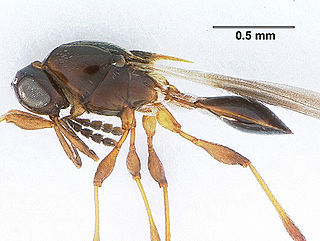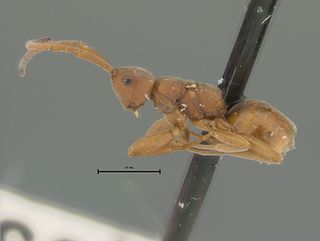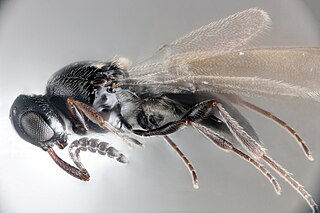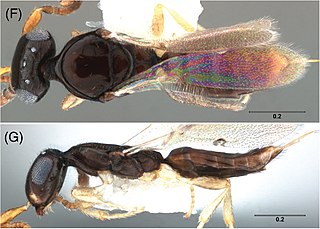
The Mymarommatidae, sometimes referred to as false fairy wasps, are a very small family of microscopic parasitic wasps. Only about half of the known species are living taxa, but they are found worldwide.

The Hymenopteran superfamily of parasitoid wasps, Platygastroidea, has often been treated as a lineage within the superfamily Proctotrupoidea, but most classifications since 1977 have recognized it as an independent group within the Proctotrupomorpha. It is presently has some 4000 described species. They are exclusively parasitic in nature.

The hymenopteran family Platygastridae is a large group of exclusively parasitoid wasps, mostly very small (1–2 mm), black, and shining, with geniculate (elbowed) antennae that have an eight-segmented flagellum. The wings sometimes lack venation, though they may have slight fringes of setae.

Trigonalidae is one of the more unusual families of hymenopteran insects, of indeterminate affinity within the suborder Apocrita, and presently placed in a unique superfamily, Trigonaloidea, and the only extant taxon in the superfamily. The other putative related taxon is the extinct family Maimetshidae, known from the Cretaceous period. Trigonalidae are divided into 2 subfamilies; Orthogonalinae and Trigonalinae. These wasps are extremely rare, but surprisingly diverse, with over 90 species in 16 genera, and are known from all parts of the world. It is possibly the sister group to all Aculeata.

The hymenopteran family Scelionidae is a very large cosmopolitan group of exclusively parasitoid wasps, mostly small (0.5–10 mm), often black, often highly sculptured, with (typically) elbowed antennae that have a 9- or 10-segmented flagellum. It was once considered to be a subfamily of the Platygastridae, but has been revived in the most recent classification of Platygastroidea.

The Stephanidae, sometimes called crown wasps, are a family of parasitoid wasps. They are the only living members of the superfamily Stephanoidea. Stephanidae has at least 345 living species in 11 genera. The family is considered cosmopolitan in distribution, with the highest species concentrations in subtropical and moderate climate zones. Stephanidae also contain four extinct genera described from both compression fossils and inclusions in amber.

The Ceraphronoidea are a small hymenopteran superfamily that includes only two families, and a total of some 800 species, though a great many species are still undescribed. It is a poorly known group as a whole, and most are believed to be parasitoid or hyperparasitoids.

Conostigmus is a genus of parasitoid wasps belonging to the superfamily Ceraphronoidea. It is the second-largest genus within the family Megaspilidae. The genus has a worldwide distribution with over 170 extant species.

Telenominae is a subfamily of parasitoid wasps in the family Scelionidae. It was previously considered a subfamily of Platygastridae.

Embolemidae is a family of small solitary parasitoid wasps with around 70 species in 2 genera distributed around the world. The few species whose biology is known are parasites on planthopper nymphs of the families Achilidae and Cixiidae. There is debate regarding the status of the genus named Ampulicomorpha by Ashmead in 1893, generally considered now to be a junior synonym of Embolemus (e.g.,), though some authorities dispute this (e.g.,)
Oethecoctonus is a genus of parasitoid wasps in the family Platygastridae. There are about six described species in Oethecoctonus.

Teleasinae is a subfamily of parasitoid wasps in the family Scelionidae. It was previously considered a subfamily of Platygastridae.
Metaclisis is a genus of parasitoid wasps in the family Platygastridae. There are at least 30 described species in Metaclisis.

Trichacis is a genus of parasitoid wasps in the family Platygastridae. Members of this genus have a tuft of setae on the mesoscutellum and transverse striae or rugulae above the antennae. They are parasitoids of Cecidomyiidae, although the hosts of most species remain unknown.
Idris is a genus of parasitic wasps in the family Platygastridae, containing about 160 described species. This genus is part of the tribe Baeini, which are egg parasitoids. Members of the genus Idris are mostly parasitoids of spider eggs, but at least one member of the genus uses stink bugs as hosts.
Sparasion is a genus of wasps belonging to the family Sparasionidae, whitin the superfamily Platygastridae. The genus has specimens widespread in Eurasia, Africa, and temperate North America.

Neuroscelionidae is a family of wasps in the superfamily Platygastroidea. It contains only one extant genus, Neuroscelio, with two other genera known from fossils. Members of Neuroscelio are known from Southeast Asia and Australia. Their hosts are unknown.

Nixonia is a genus of wasps. It is the only member of the family Nixoniidae in the superfamily Platygastroidea. They are amongst the largest of the platygastroids at up to 9 mm in length. Members of the genus are known from Africa, the Indian subcontinent and Southeast Asia. The biology of only one species is known, which parasitises orthopteran eggs.

Janzenella is a genus of wasp, the only member of the family Janzenellidae within the superfamily Platygastroidea. It contains only a single living species, Janzenella innupta, which has only been collected in Costa Rica. Fossil members of the living species have also been described from Miocene aged Dominican amber. A Late Eocene fossil species, Janzenella theia is known from specimens entombed in Baltic amber.

Geoscelionidae is a family of wasps in the superfamily Platygastroidea. It contains three extant species in two genera, native to South America and Africa, and several other genera known from fossils. It was originally erected as the tribe Geoscelionini within Scelionidae. It was raised to a full family in 2021.
















